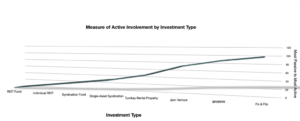Not long ago, individuals had somewhat limited options when investing in real estate . Either they could buy a rental property, usually a single family home or a small multifamily, or invest in a REIT. One choice very active. The other very passive. Over the last decade, the landscape of real estate investing has changed considerably. Due to relaxed government policy impacting crowdfunding regulation, along with the emergence of “fintech,” investors now have access to markets and deals previously available only to a select few. Private real estate offerings have soured and demand for them is only increasing. It’s not hard to see why when yields in real estate dwarf traditional fixed-income alternatives. Today options are not so black and white, ranging from very passive to very active and everything in between.
Naturally, with more options come more decisions. Where should investors looking to put capital to work in real estate start? By Weighing the pros and cons of investing actively versus passively, and matching investment objectives with feasibility, you will arrive at where you land on the continuum of choices.
Let’s take a look at the considerations and touch on available options so you can determine which avenue is best for your circumstances.
How Much Time Do You Have?
Are you working a full-time job? Actively investing in real estate takes a lot of time and effort. Nobody intends to take on a second job when they decide to invest in real estate, but that’s what can happen. If you are flipping houses, rehabbing properties you intend to rent, or partnering with a friend or two on a joint venture investment, there’s a fair bit of day-to-day management.
Before you get started, you’ll need to build relationships with brokers, wholesalers, and potentially banks, while hunting for good deals and making lots of offers. Before having an offer accepted and making it to closing, you’ll need to find contractors who you can trust. I’d argue that you should have a basic understanding of the phases of construction and how building material and code has changed over time, to keep your contractor honest. True unless you want a major unforeseen headache or like to gamble. Then you’ll need to decide if you will self-manage or hire a third party property manager – also a skill to be honed or a relationship that should be cultivated.
For most, this is simply not feasible. This is not a cottage industry anymore. There are people out there working full-time, myself included, with systems and relationships in place to compete for the best deals. Sure, you can find a house to buy tomorrow. But can you find one in your free time that will produce enough cash flow to meet your investment goals, without a major renovation required?
Passive investing is a great alternative for those that don’t have the time to put forth the effort it requires to get started investing actively. There is still a time commitment in finding the right operator to partner with, or identifying a REIT with a long-term track record of increasing dividends and producing returns for its shareholders . In the identification phase the goal should be finding an operator/sponsor/company with whom you can trust your hard earned money. This is the first and most important step. You want to be sure they can set and execute realistic projections and have a solid track record of doing so. Once identified, you can decide what opportunities make sense based on your investment goals and risk tolerance. Compared to actively investing, this passive approach is a very simple and repeatable process towards earning passive income with much less of an ongoing time commitment.
How Much Control Do you Want?
Do you have a hard time delegating tasks because you feel that if you want something done right, you do it yourself? Or do you like to set-and-forget with little interest for fine details?
With an active approach to real estate investing, you are running a business. You have control over the properties you invest in, what to upgrade or keep, the cosmetic finishes to use, the vendors you choose to partner with, and the tenants you select. Any result, ultimately, rests on the shoulders of the decision maker. You!
You still have control when you invest passively, as to the deals and sponsors you allocate capital. But as a limited partner or shareholder in a deal, you have zero say in the day-to-day operations of the property or business. Once you’ve committed to the investment, you are there to sit-back, check-in on updates occasionally, and collect your mailbox money. Not a bad approach at all. Just understand that you are handing over the keys (your money!), so you better have some trust and confidence established.
Many times it makes sense to take this approach. With a professional handling your capital, you can avoid many mistakes and headaches you may encounter as part of the active investing learning curve. That in itself can save you money and potentially lead to higher returns. Mistakes can be costly!
Is Diversification Important?
As an active investor, it is very difficult to diversify geographically. Real estate is very “local” and market specific. What’s happening in New York is not what’s happening in Denver, for example. The point is that it’s paramount to understand the market you are investing in. Usually, that means if you want to be active, you need to invest in your local market. You certainly can buy rental property anywhere in the country. However, you inherently will need to become more passive from afar, as you’ll need boots on the ground managing the day-to-day. You can’t reliably address a backed-up sewer line from 2,000 miles away, so you’ll need a local team established before the investment can become more passive.
The more passive the investor, the more potential for diversification. If you own a REIT fund, you could have exposure to thousands of properties and dozens of companies, with a click of a button. If you want exposure to private offerings via a syndication, bets can be spread across asset type, class, operator, and geography. If one investment isn’t performing as expected, others are performing better than anticipated, smoothing out volatility. For this reason alone, I benefit from investing passively as a limited partner, even though I take a very active role in the majority of my investments.
Do You Have Liquidity Needs?
Although the benefits to holding real estate long-term are plentiful, sometimes reasons arise to sell. Considering your liquidity needs should be top of mind prior to making any investment. Investing in real estate, actively or passively, is not very liquid when compared to other assets. If you own a rental you’d like to sell, for example, there may be the need for capital updates prior to listing the property yourself or with a broker. After you accept an offer, the buyer could perform and inspection, potentially revealing defects they would like repaired prior to closing. They may be using traditional financing to purchase the asset and be at the mercy of the bank’s timeline. All this activity takes time and effort. If you need your money, you may be waiting awhile. It could take even longer to sell if you mis-price the property or inventory is high due to market softening.
Passive investing can actually be even less liquid than active investing. When you commit capital to a syndication, you are likely locking-up your money for 5-7 years or longer. If you run into a situation where you need the cash, it will be very difficult to get your principal back prior to the sale of the asset. Be prepared to lock-in for the long-haul.
There is an alternative – REIT Investing. The biggest advantage of real estate exposure via REITs is liquidity. At the click of a button, you can enter and exit positions effortlessly, as you are buying a stock, not the real estate itself. But there is a trade-off.
What Kind of Returns Are You Aiming For?
The ultra-passive approach of investing in real estate by buying REITs is likely going to lead to lower returns versus the alternatives. REITs typically buy stabilized assets that produce income that’s very predictable, in order to pay shareholders a consistent dividend. Those yields don’t compare with other real estate investment options. Sometimes, as was the case in the summer of 2020, REITs trade at massive discounts to their net asset value (NAV) and are mis-priced. This allows value-investors an opportunity to buy quality companies on-sale and earn atypical overall returns.
Generally speaking, syndications will offer the potential for more upside, though. A more concentrated exposure increases risk, but with a bit more risk comes the opportunity for higher returns. Sponsors typically look for mismanaged properties. Opportunity exists with properties in need of upgrades, with potential for rent bumps and operational overhauls . By implementing a value-add strategy, sponsors can increase the operating income of the property. This leads to a higher valuation and a bigger payoff for the investors.
However, the potential for even higher returns exist for the active investor. You run the show. You don’t have to pay sponsor fees, and if working alone, won’t have profit splits. Additionally, if you are classified as a “real estate professional,” the most active type of investor, you are afforded some incredible tax benefits allowing you to write-off depreciation against “active” income. Passive investors in syndications have some great tax advantages as well. Understanding the tax code and the benefits of real estate professional status can really help juice your after-tax returns. This is the topic of another post.
Wrap-Up
The reality is the difference between active and passive investing isn’t black and white. It’s rather more of a continuum of choices with pros and cons to each option. You can make an active investment more passive by outsourcing aspects of the business that others perform more efficiently, allowing you to focus on your strengths. In my business, property management is outsourced, as the focus is on raising capital, closing deals, project management, and asset management. You can also make a passive investment more active. There are a fair number of full-time passive investors spending their days building relationships with sponsors, analyzing deals, and even pooling capital from other passive investors.
The chart below provides a basic conceptualization of the most passive to the most active investment approaches.

I’m invested in most of these investment options. As a professional in the business, I enjoy being actively involved and earning returns that I could not achieve without that level of participation. However, investing alongside syndicators with proven track records, coupled with gaining passive diversification outside my market, I see as invaluable. These passive options provide for very attractive investments for those looking to achieve many of the benefits of active investing without the downsides.
Are you a passive or active investor? What should someone looking to get into real estate consider before investing?


